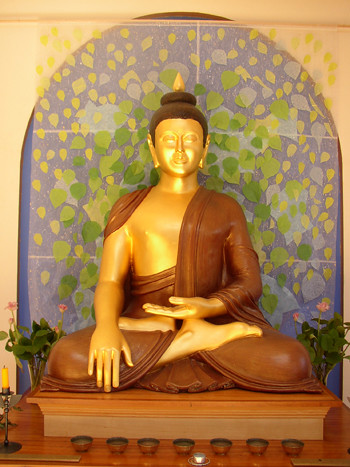Buddharupa
A Buddha statue is the plastic, usually idealized image of a Buddha, most of the religious founder of Buddhism, Siddhartha Gautama. Aniconic representations are very early images of the person himself, however, is only from the 2nd century BC. Since then, a great art and variety of shapes has evolved.
History
When the Buddha knew that death would overtake him soon, he told his disciples that they would now take the initiative and go on with his work without him. His disciple, Ananda became clear that the doctrine would be forgotten with time, if not some way would be found to keep the memory of the Master. Could not the disciples perform a regular act of homage, he asked the master sad. Could not they have some sort of replacement, a kind of " thinking time " both for his person as well as for teaching? In order to satisfy needs of this kind, replied the Buddha, can the believer like to go on a pilgrimage to the places of his work. In these places he could recall the associated events in the victory over evil and the ignorance then to be inspired to follow suit. If that is not enough, they could after his cremation his bodily relics ( Sanskrit: sariradhatu, Pali: dhatucetiya ) and take over them stupas ( Pali: paribhogacetiya, Thai: Chedis ) build. This would remind people of the teaching and make their hearts happy.
Thus in the first Buddhist art works, as not to be seen on the reliefs of the Stupa of Sanchi, the Buddha eg self. He is represented only by symbols that represent specific scenes from the life of the Master:
- A lotus - bud as a symbol of his birth.
- The Bodhi Tree
- An empty seat under the Bodhi tree, which is sheltered by the Naga King Muchalinda, reminiscent of the enlightenment.
- The wheel ( dharmachakra ) commemorates the first sermon, in which " the Wheel of Dharma in motion " was.
- Footprints ( phuttabat ).
- " Fiery energy ", which is presented as Aureole.
- The Stupa ( Thai: Chedi ) recalls its entrance into Nirvana ( in Pali language: parinibbana ).
In ancient pre-Buddhist cultures of India, some of these symbols have been worshiped: the Sun's disk (sun ), the serpent and tree and stone spirits.
The first images that represented the master in his human form, appeared around the first century BC, about the same time in Gandhara (now Afghanistan) and Mathura ( North India ) on. The Ceylonese chronicles suggest that first iconic images of the Buddha were made in the third century before Christ; However, archaeological evidence for this assumption is so far failed to materialize. The already known symbols were still used in the presentation. Where the production of such images has begun, is still unknown, but the majority of the images found are from Gandhara.
( More on the history see: Buddhist Art)
Immediately after their formation spread, also in mutual interaction, the first few representations of the Buddha in rapidly growing number and diversity of regional. It also developed related art and teaching traditions and lore that certain forms of presentation or individual sculptures spend as particularly truthful. A frequent topos is that an artist have looked on behalf of a king the Buddha directly, and then create the portrait, which secular and religious legitimacy were intertwined.
Even in areas where Buddhism eventually had to give way to other religions again, remained and remain respected Buddha images often over the centuries, there have been isolated but has also been attacked. The destruction of the giant Buddha statues of Bamiyan by the Taliban Islamist therefore sparked worldwide outrage and had to be enforced against the resistance of the local Hazara.
Purpose
A Buddha statue is not created as a decorative piece of art or just to delight the eye. The intention is rather to the viewer to remember to teach or maybe even enlighten. The creation of a Buddha statue is considered a " good deed ", which it is hoped a positive influence on the next rebirth. Much like the stupas they served first the preservation of relics, however, were in the course of time and in memory relic.
Buddha statues today
Today, representations of the Buddha not only in the religious life are almost all Buddhist schools and forms of popular religiosity firmly integrated. They enjoy great popularity even beyond about as fashion items for the living room or even gardens of wealthy people around the world who want to establish the somewhat spiritual chic and show their openness to the world. Aniconic symbols, however, have declined in importance, albeit for example, the dharma wheel was added to the national flag of India. As in Christianity it is in Buddhism today usually forget that representations of the founder of the religion, nor to worship purposes to were initially uncommon.
Buddha heads
Lately, heads of Buddha statues in trendy stores or by mail are becoming more common. This may mislead the gullible viewer to believe Buddha heads are their own form of representation. The heads, however, were not originally manufactured, but are always part of a complete statue. You have fallen away either over the centuries by the influence of wind and weather in the hull, or they were deliberately removed, as it was by the Burmese, for example, in the conquest of the Siamese capital of Ayutthaya in April 1767. Today heads are industrially manufactured to meet the world's growing demand for easy transporting decorative objects.
Stylistics, by country (selection)
The iconography of the Buddha statues is defined differently in different countries:
- Thailand
- Japan (see Daibutsu )










.jpg)